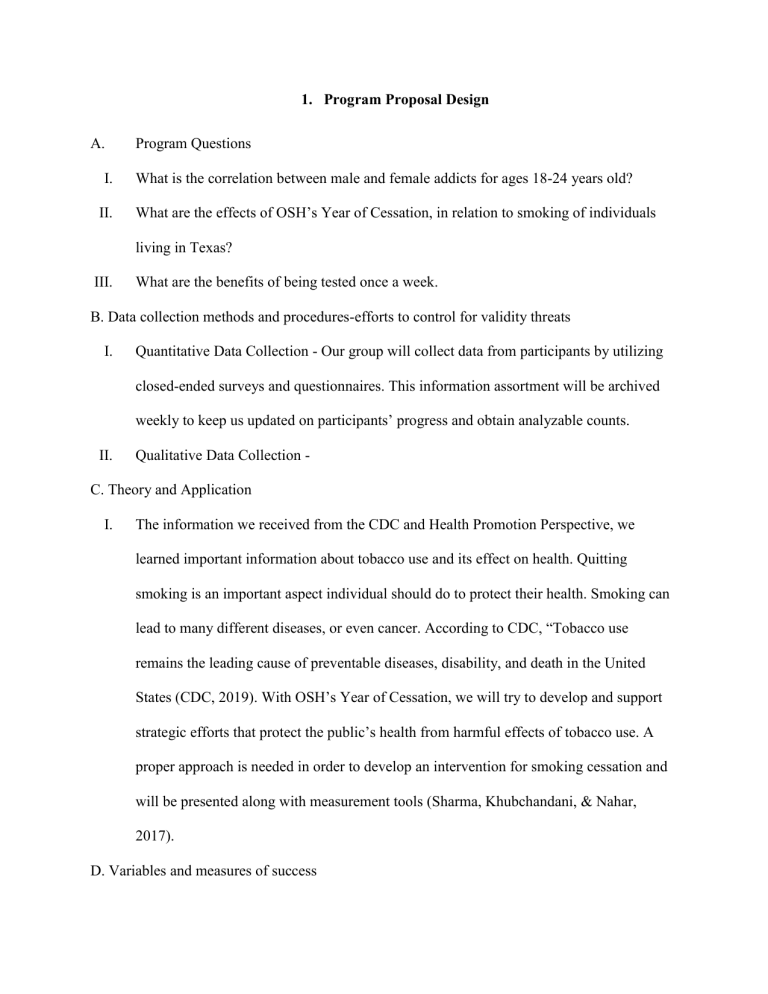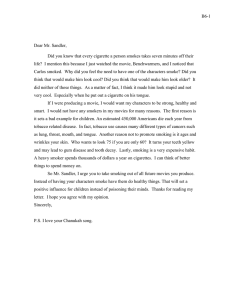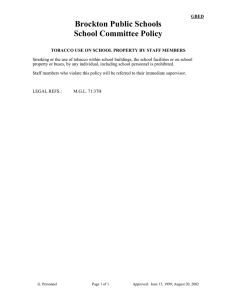
1. Program Proposal Design A. I. II. Program Questions What is the correlation between male and female addicts for ages 18-24 years old? What are the effects of OSH’s Year of Cessation, in relation to smoking of individuals living in Texas? III. What are the benefits of being tested once a week. B. Data collection methods and procedures-efforts to control for validity threats I. Quantitative Data Collection - Our group will collect data from participants by utilizing closed-ended surveys and questionnaires. This information assortment will be archived weekly to keep us updated on participants’ progress and obtain analyzable counts. II. Qualitative Data Collection - C. Theory and Application I. The information we received from the CDC and Health Promotion Perspective, we learned important information about tobacco use and its effect on health. Quitting smoking is an important aspect individual should do to protect their health. Smoking can lead to many different diseases, or even cancer. According to CDC, “Tobacco use remains the leading cause of preventable diseases, disability, and death in the United States (CDC, 2019). With OSH’s Year of Cessation, we will try to develop and support strategic efforts that protect the public’s health from harmful effects of tobacco use. A proper approach is needed in order to develop an intervention for smoking cessation and will be presented along with measurement tools (Sharma, Khubchandani, & Nahar, 2017). D. Variables and measures of success I. Independent variable- Use of tobacco II. Dependent variable- Effects on health III. Nominal level- age and gender E. Instruments for data collection I. Our data collection will consist of 100 people, males and females, in Texas whose ages range from 18-24 to collect data. Members of this program will initially be approached to complete a categorical survey ("yes/no") multiple choice questions that offer respondents predefined response choices to pick about their use of tobacco. Members from this program will furthermore experience a participatory discourse between health professionals encouraging smoking discontinuance (i.e. advisor, wellbeing teacher, ensured wellbeing instruction expert, ect.) and the individual needing to stop in which the facilitator attempts to underscore the benefits of stopping over the inconveniences. Weekly logs and diaries will likewise be utilized as an instrument by members in program for smoking discontinuance. These logs will be utilized as a guide to archive one's emotional prosperity to the objective of being without smoke, various approaches to remain motivated, and defeat any contemplations of vulnerability in accomplishing the goal of being smoke free. F. Sampling Procedures I. We will be observing 100 individuals between the ages of 18 and 24 years old. This data will be collected on males and females who live around the state of Texas. II. In this sample we are going to choose individuals who are trying to quit smoking and are ready to give OSH’s Year of Cessation a try. III. Whichever individuals agree to participate are the ones we will use in our program. G. Planned Data Analysis Procedures and Statistics I. The methods of data collection that will be utilized for Smoking Cessation 2020 will incorporate interviews and surveys to arrange and examine the advancement of members. The information obtained will likewise assist us with reaching the ideal goals for the program and participants of program. H. Timetable or Activity Chart Introduce OSH 2020 to participating members. Will discuss the background of program, goals of program, possible tobacco free date, and will also connect members with other participants of program for support system. Participants will meet with a health professional to discuss the history of their smoking habit, discuss their nature of wellness, and what triggers them to smoke. Participants will write down why they desire to quit smoking and how they think they’ll feel after quitting (physically, emotionally, and spiritually). I. Program Activities and Strategies 1. Maintain a strategic distance from places where substantial smoking is generally pervasive. 2. Chanel desire to smoke into something that is fulfilling. 3. Physical activity at any rate of 30 minutes per day to cause tobacco cravings to leave and lessen the force of desires 4. Unwinding methods at any rate of 30 minutes per day to manage emotional stressors that may trigger desires, for example, yoga, journaling, spiritual reflection, or tuning in to quieting music. 5. Expelling all tobacco from home. In the event that one cigarette is left, enclose it by a paper with anticipated date to stop as a suggestion to stop. J. Adapted Inclusion We understand participants with disabilities face various limits to wellbeing openings in their networks and inclusion is fundamental. To accommodate the needs of members with incapacities, we will have an alternate approach to help members of our program have a successful result on their quest to stop smoking. Scenario of Adapted Inclusion: John is a 25-year-old male on the spectrum and suffers from severe depression. During times of frustration or self-doubt, John finds himself going through a pack of cigarettes a day. He is desperate to quit smoking as he feels his mind is constantly focused on the next cigarette. OSH will first assist John by: 1. Explain to John the hazardous effects of smoking by using pictures to better communicate the severity of using tobacco. 2. John will go through a participatory dialogue with health professional to discuss trigger points that cause him to smoke and how he feels when he smokes (play therapy can be used for this step) 3. An objective will be implemented by health care professional which will implement John’s desired goals, expected quit date will also be discussed. 4. John will keep a weekly log or journal on how cutting back on smoking makes him feel by using communication board with counselor. 5. Progress towards John’s goals and behavior observations will be documented weekly by healthcare professional.



